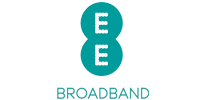Sky broadband vs EE broadband
By Marc Shoffman | Tuesday, August 3rd 2021
Sky is a longstanding giant of the broadband world, while EE is a relatively newer arrival onto the internet patch. We have an attacker and a defender then. But which one is best?
UK households have been enjoying Sky broadband since its launch in 2006, whereas EE only inherited customers following its takeover of Orange and its internet services in 2012. But EE knows a bit about communications, having the UK’s largest 5G network and is now also under the BT umbrella, having been bought by the telecoms giant in 2015.
Broadband speed
Sky and EE both run on the Openreach network, but their average speeds differ slightly. For standard broadband, Sky offers 11Mbps download speed, and EE offers 10Mbps. For entry-level fibre, only EE offers 36Mbps average speeds, with Sky now skipping this speed level completely. EE pips Sky to the post at the top speeds by offering 67Mbps against Sky's 59Mbps. Decent download speeds are an important factor, so you know there won’t be too much buffering as you stream films, listen to music or play video games. Equally, the faster your speed, the more devices your connection will be able to support at once.
But it is also important to know how long it will take to upload photos and send emails – actions like these come under the heading of upload speed. You will get upload speeds of 1Mbps with both Sky's and EE’s standard broadband packages.
EE has a decent 10Mbps upload speed on its 36Mbps fibre package, while Sky now has no equivalent low-end fibre deal. Both EE and Sky have upload speeds around 19Mbps with their top-end fibre packages. Most people won't ever notice a problem with upload, as it's only useful for a few specialised tasks and doesn't often come into play during everyday use.
Conclusion
There isn’t much between these two on speeds. Both are pretty good for both downloads and uploads so you will be getting reliable internet whichever you choose.
Deals and Packages
EE offers three different broadband speeds to Sky's two. They both operate on the Openreach network, which is used by the vast majority of broadband providers. EE’s Unlimited Broadband offers 10Mbps, and EE Fibre Broadband offers 36Mbps. Its fastest package is Fibre Plus Broadband, offering 67Mbps. EE users get monthly line rental and unlimited usage included as standard. Set-up fees tend to vary across packages.
Sky offers only two package levels by comparison (the 11Mbps Sky Broadband Essential, and 59Mbps Sky Broadband Superfast packages). Both providers are pretty rigid on contract lengths. All EE’s deals are for 18 months, as are Sky’s packages.
Sky and EE also now offer customers Ultrafast broadband. However, these high speeds are only available in a limited area at the moment. You can check whether you are one of the lucky ones by visiting the respective websites of each provider. Sky offers up to 145Mbps, and EE offers up to 145Mbps, 300Mbps and 900Mbps.
Both providers only offer customers pay-as-you-go calls as standard, with the option to add on call packages for evenings and weekends, anytime calls or international calls for an extra monthly fee.
Conclusion
There isn’t much to differentiate these two on packages, with EE just pipping Sky to the post on speed with its top fibre package.
-
 No set-up feeSky Broadband Superfast
No set-up feeSky Broadband Superfast- 59Mb average speed +
- Unlimited usage +
- PAYG calls
- No set-up fees (save £19.95)
£23 per monthNo set-up fee£0 one-off cost18 month contract -
 No set-up feeSky Superfast 35
No set-up feeSky Superfast 35- 36Mb average speed +
- Unlimited usage +
- PAYG calls
- No set-up fees (save £19.95)
£30.50 per monthNo set-up fee£0 one-off cost18 month contract -
 EE Fibre Broadband only
EE Fibre Broadband only- 36Mb average speed +
- Unlimited usage +
- No phone line
£24 per month£0 one-off cost24 month contract -
 EE Standard Broadband with landline
EE Standard Broadband with landline- 10Mb average speed +
- Unlimited usage +
- PAYG calls
£24 per month£10 one-off cost24 month contract
Customer service
EE does pretty well when it comes to customer service. The latest Ofcom figures from 2020 show that 88% of EE customers are satisfied with their service overall, which is more than the average at 85%. In comparison, 86% of Sky customers are happy with their service overall.
However, 15% of EE customers had a reason to raise issues, which is fractionally above the industry average of 13%. But on the upside, 66% of those who did raise a complaint were satisfied with how it was handled – an industry best – and more than Sky with 62%. The sector average was 53% so both providers score reassuringly well when it comes to dealing with customer complaints.
EE customers tend to get through to customer services pretty fast, with average waiting times of just 26 seconds, compared with a typical 2 minutes 10 seconds across all broadband providers. Sky takes somewhat longer to pick up the phone, at 2 minutes 28 seconds.
When it comes to wanting to get in touch, EE offers its live chat service seven days a week from 8am to 9pm, or you can get in touch by phone on 0800 079 8586 from an EE landline or by calling 150 from an EE mobile. There is also an EE customer forum where you can raise issues and see if others are facing similar problems and find solutions.
EE customers can also get in touch via the provider’s Facebook and Twitter pages, both of which are manned seven days a week.
If you go with Sky, you can call customer services daily on 0333 7591 018, get in touch by using Sky’s live chat service, or via social media on the provider’s Twitter and Facebook pages. Sky also has a community forum that you can visit to get solutions and advice from other customers.
Both Sky and EE offer a little extra to those keen to switch to their services. Sky will pay up to £100 of your exit fees if you are charged fees by your existing provider to leave early, and EE will pay up to £50 with their Early Cancellation Credit scheme.
Conclusion
Sky and EE score highly for customer service and seem easy to get hold of, while resolving problems well when they arise. This is reassuring for customers of either provider as you know you have a better chance of being treated well.
Router and equipment
The technology you get with EE depends on the package you choose. Standard broadband users get the EE Bright Box, which supports remote assistance, has four ethernet ports and a built-in dual-band antenna. Fibre broadband customers get better tech with EE’s Smart Hub. It comes with seven internal antennas, dual wi-fi bands, four gigabit ethernet ports and the ability to set when certain devices can access it.
In comparison, all new Sky customers will receive the latest Sky Broadband Hub, which is supplied with all Sky broadband packages, whether fibre or no, which makes it easier to upgrade to a faster download speed. The dual-band Sky Broadband Hub comes with four ethernet gigabit ports, eight antennas, and will let you connect up to 64 devices at the same time. It also employs smart channel selection so that it will constantly connect to the fastest wifi frequency available, and constantly scans the connection for any problems.
Conclusion
Broadband customers don’t like being treated differently to each other, especially if they are using the same provider. So Sky wins on this round as no matter what package you choose, you will always get its most up-to-date technology with Sky, unlike EE, which reserves its best router for fibre customers.
Extras
All EE’s broadband packages are accompanied by a year’s free Norton Security Premium, which can be used on up to 10 devices. You also get parental controls. EE mobile users who sign up for EE broadband can also get a free data boost of up to 20GB on a pay monthly mobile or 12-month SIM-only plan, as well as a 10% monthly discount on the price of their EE broadband.
To keep your home broadband running optimally, EE customers can pay an extra tenner a month for EE Smart WiFi. This comes with a Smart WiFi booster which will keep you online throughout your home, along with a 4GEE WiFi Mini hub, which comes with 2GB of data to use every month both at home or when you are out. Plus, should your home broadband connection drop out at any time, EE will boost the 4GEE Mini with an extra 250GB of data to keep you connected until your broadband service is fixed.
1bbd.jpg)
Sky also offers virus protection, through a McAfee Internet Security Suite trial for 12 months. It also has Sky Broadband Shield that lets you filter websites and customise your privacy settings into age categories. You can also set age rating restrictions depending on the time of day. This could be a good way to get the kids off their devices at bedtime.
Sky customers wanting to get the best from their broadband connection can choose to sign up to Sky Broadband Boost for an extra fiver a month. This guarantees you a wifi connection in every room of your house of 3Mbps or more. In addition, Sky will run daily checks on your line to confirm everything is running smoothly and if you do have a problem, you can book an engineer visit at a time that is convenient to you - including in the evening and at weekends.
As a Sky broadband customer, you can also use your internet on the move with the Sky WiFi app, providing free internet access at 22,000 hotspots across the UK courtesy of The Cloud.
Conclusion
Although both providers off decent online security and parental controls, EE wins this time by offering discounts and data boosts to customers that sign up for both EE broadband and mobile, and although EE’s smart wifi solution is more expensive than Sky’s, its 4GEE Mini offers both peace of mind as well as extra free data, neither of which are on offer from Sky.
Overall
Both Sky and EE bring decent speeds, packages, routers and top customer service. EE offers marginally superior customer satisfaction standards compared to Sky, and also has extra benefits up for grabs for customers that take both its mobile and broadband services together. EE on balance is more expensive than Sky, but the option to sign up for Smart WiFi with the 4GEE Mini hub to keep you connected at all times takes EE’s broadband offering to another level.
